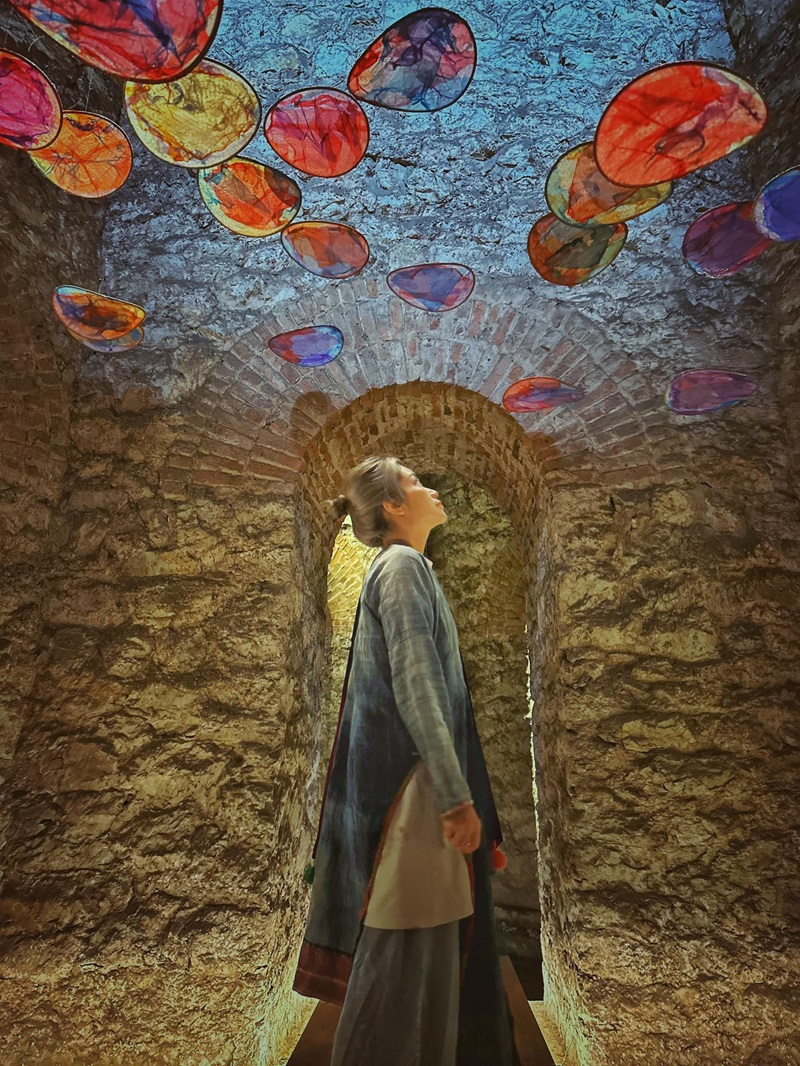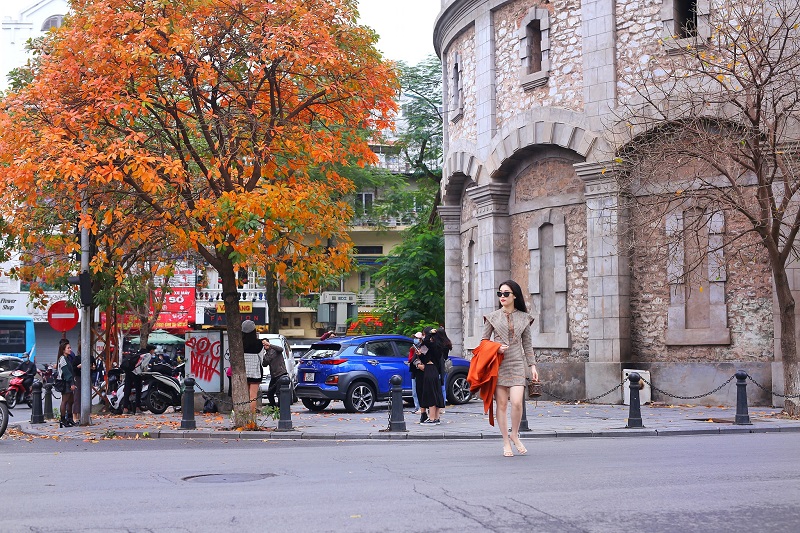
Hang Dau Water Tower has attracted many visitors thanks to its structure of the building built in the late 19th century by French colonists.
The reputation of the tower has been enhanced after the installation art exhibition during the Hanoi Creative Design Festival last year.
| Dawn at the Hang Dau Water Tower. Photo: Nam N |
Hanoi's first safe water supply station
In the 19th century, after the seizure of Hanoi in 1882, French colonialist troops stationed at the Hanoi Citadel and at locations in Tho Xuong District (then the center of Hanoi Province in 1883) to fight insurgents of the anti-French Van Than movement.
Accustomed to cool, temperate climates, the French soldiers found the city's tropical climate very uncomfortable. Like the natives, they dug their own wells and bathed in ponds and lakes during the scorching summers, causing many to contract scabies.
Moreover, on November 1, 1886, French Resident General Paul Bert died of dysentery. These two reasons forced the French to consider building a safe water factory.
In 1894, the French colonial government established the Department of Water Supply and built the first factory on a piece of land belonging to Thach Khoi and Yen Dinh villages or Yen Phu Ward, now Tay Ho District, initially to purify water from four wells.
| Hang Dau Water Tower is located at the intersection of Hang Than, Hang Luoc, Hang Giay, Hang Dau, Quan Thanh, and Phan Dinh Phung streets. Photo: The Hanoitimes |
At that time, oil was not widely available in the city, so the factory used a coal-fired steam engine to turn the propeller that pumped water from the wells into the filter tank. At the same time, a system of pipes was laid to bring the safe water to where it was needed.
Since many two-story houses had been built in the citadel as command posts and officers' residences, a higher water tower was needed. A site on Rue des Graines, or now Hang Dau Street, in Quan Thanh Ward, Ba Dinh District, was chosen because it was a newly leveled area near the citadel. Purified water from the factory would flow through the pipes to the tower. The water supply pipelines were initially only 21.21 kilometers long, while the pipe diameters were no more than 20 centimeters, and were later replaced with larger ones.
How the tower was built?
| Despite the passage of time, the tower has remained in its original state. Photo: Hong Minh |
In 1894, Hanoi's citadel walls were demolished and its stones were used to build the body of the water tower. The tower has a cylindrical shape, a diameter of 19 meters and a height of 25 meters. Since the factory's storage tank wasn't large, elevated steel tanks with a capacity of 1,250 cubic meters were installed in the tower to ensure supply in case the factory was shut down.
From these tanks, pipes ran to the citadel and to the streets along the route from Hang Giay Street to the Hoan Kiem Lake area, where several government offices were located. These pipes were all equipped with valves, and the Department of Water Supply would calculate the amount of water used during the day to keep the system running smoothly.
In 1896, the Yen Phu Water Plant officially began operations. From 1897 to 1899, the factory dug another large-diameter well, increasing its capacity to 2,500 cubic meters per day. By 1900, the number had reached 4,000.
| The "Light and Water" installation inside Hang Dau Water Tower within the framework of Hanoi Creative Design Festival 2023. Photo: Huong Giang |
In the report entitled "Situation of Indochina between 1897 and 1901" by Governor General of French Indochina Paul Doumer, an appendix report by Mayor Baille of Hanoi reads as follows: "The supply of clean water has been in full operation since February 24, 1900, to everyone's satisfaction. The city also negotiated with contractors to produce at least 5,000 cubic meters per day in the coming years.
In 1901, the city installed an additional 4.77 kilometers of pipe, bringing the total length of water mains to 26 kilometers. In 1901, there were 85 metered water company branches and 85 public water stands for households that could not afford a tap. The number of such branches and water posts remained the same until after World War I.
| The "Light and Water" installation is a creation of architect Cao The Anh and artist Nguyen Duc Phuong inside the water tower. |
After the Yen Phu Water Plant, four more were built in Hanoi, namely Don Thuy (in 1925, with a capacity of 2,000-4,000 m³/day), Bach Mai (1931, 400-500 m³/day), Ngoc Ha (1938, 800-1,000 m³/day), and Ngo Si Lien (1941, 4,500-5,000 m³/day).
By the time the capital was liberated on October 10, 1954, the Hanoi Water Supply Department had five safe water purification plants with a total capacity of 26,000 cubic meters per day and a pipeline artery with a total length of nearly 100 kilometers.
At that time, 58% of Hanoi's population, including 24,000 inner-city residents, had access to piped water. Accordingly, the number of workers in the department grew from about 50 to more than 300, who installed, maintained, and repaired the machines, filter tanks, and pipelines.
The Hang Dau Water Tower ceased operation in 1960. In the early 21st century, an investor proposed a project to demolish the tower to make way for a new building. Fortunately, no permission was granted.
A charming tourist attraction
| The beauty of Hang Dau Water Tower in Loc vung leaf-changing season. Photo: The Hanoitimes |
Hang Dau Water Tower possesses classical beauty and impressive majesty, providing a wonderful check-in background for Hanoi residents and tourists.
Regardless of the season of the year, you can easily see groups of friends gathering here for nice snapshots.
Especially at the end of March, the old tower becomes poetic, fascinating, and enchanted by the loc vung or Barringtonia acutangula in the leaf-changing season. The whole area is bathed in breathtaking colors as the leaves change from yellow to red and green.
The bright colors have helped this old French building become vibrant and fresh, adding to the ancient beauty of Hanoi.
Currently, the Hanoi government has introduced a policy to develop cultural industries. Accordingly, the Hang Dau Water Tower can be considered an "industrial heritage site". Through sustainable exploitation, this ancient waterworks promises to become a fascinating cultural attraction of the capital city.
| The old French building has now become a tourist attraction in Hanoi. Photo: Dung Dang |






- Untold tale of Hang Dau Water Tower
- Hanoi's lively Mid-Autumn Festival a century ago
- Kinh Thien Palace restoration: Reviving national history
- Explore historical relics on Ngoc Khanh Lake's new pedestrian path
- We're too censorious about heritage preservation efforts
- Hanoi's parks and flower gardens – little known stories







